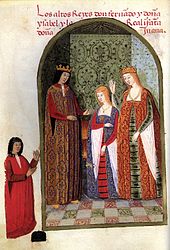Juana dari Kastilia
Juana dari Kastila (bahasa Inggris: Joanna; 6 November 1479 – 12 April 1555), disebut Gila (bahasa Spanyol: Juana la Loca), adalah Ratu Kastila dan León dari tahun 1504 dan Aragon dari tahun 1516. Dari penyatuan dua kerajaan ini terbentuk Spanyol modern di masa mendatang.[1] Pada 20 Oktober 1496, Juana menikah dengan Felipe, putra Maximilian I, Kaisar Romawi Suci. Saat ibunya, Isabel dari Kastila, mangkat pada tahun 1504, Juana diangkat sebagai Ratu Kastila dan León yang baru, sedangkan Felipe dinobatkan sebagai Raja Kastila dan León pada tahun 1506, memulai kekuasaan wangsa Habsburg di Spanyol. Setelah kematian Felipe pada tahun yang sama, Juana dianggap mengalami gangguan mental dan hidup membiara di sisa hidupnya. Meskipun dia tetap berkedudukan sebagai Ratu Kastila dan León yang sah, ayahnya, Fernando II, menjadi walinya dalam memerintah kerajaan sampai mangkatnya, menjadikan Juana mewarisi takhta sang ayah sebagai Ratu Aragon. Dari 1517, anaknya, Karl, memerintah sebagai raja, sementara Juana, secara simbolis, tetap berperan sebagai ratu.
| Juana | |
|---|---|
 | |
| Ratu Kastila dan León | |
| Berkuasa | 26 November 1504 – 12 April 1555 |
| Pendahulu | Isabel dan Fernando V |
| Penerus | Carlos I |
| Wali | See
|
| Ratu Aragon | |
| Berkuasa | 23 January 1516 – 12 April 1555 |
| Pendahulu | Fernando II |
| Penerus | Carlos I |
| Kelahiran | 6 November 1479 |
| Kematian | 12 April 1555 (umur 75) Tordesillas, Spanyol |
| Pemakaman | Capilla Real, Granada, Spanyol |
| Pasangan | Felipe I, Raja Kastila dan León |
| Keturunan | Leonor, Permaisuri Portugal dan Prancis Carlos I, Raja Kastila dan Aragon Isabel, Permaisuri Denmark, Norwegia, dan Swedia Ferdinand I, Kaisar Romawi Suci Maria, Permaisuri Hungaria Catalina, Permaisuri Portugal |
| Wangsa | Trastámara |
| Ayah | Fernando V, Raja Aragon |
| Ibu | Isabel, Ratu Kastila dan León |
| Agama | Katolik Roma |
Early life

Juana lahir di kota Toledo yang merupakan ibukota dari Takhta Kastila. Dia adalah anak ketiga dan putri kedua dari Isabel dan Fernando. Joanna was born in the city of Toledo, the capital of the Kingdom of Castile. She was the third child and second daughter of Isabella I of Castile and Ferdinand II of Aragon of the royal House of Trastámara. Joanna was a clever and diligent child and an excellent student. Queen Isabella ensured that Joanna, along with her three sisters Isabella, Maria, and Catherine, received a fine education .[2]
In 1496, Joanna, at the age of sixteen, was betrothed to Philip the Handsome, Duke of Burgundy (titular), in the region of Flanders in the Low Countries. Philip's parents were Maximilian I, Holy Roman Emperor and his first wife, Duchess Mary of Burgundy. The marriage was one of a set of family alliances between the Habsburgs and the Trastámaras designed to strengthen both against growing French power.
Putri Asturias
The death of Joanna's brother John, the stillbirth of John's daughter and the deaths of Joanna's older sister Isabella and Isabella's son Miguel made Joanna heiress to the Spanish kingdoms. Her remaining siblings were Maria (1482–1517) and Catherine (1485–1536), younger than Joanna by three and six years, respectively.
In 1502, the Castilian Cortes of Toro[3][4][5] recognised Joanna as heiress to the Castilian throne and Philip as her consort. She was named Princess of Asturias, the title traditionally given to the heir of Castile.[6]
Naik takhta
Upon the death of her mother in November 1504, Joanna became Queen regnant of Castile and her husband jure uxoris its king. Joanna's father, Ferdinand II, lost his monarchical status in Castile although his wife's will permitted him to govern in Joanna's absence or, if Joanna was unwilling to rule herself, until Joanna's heir reached the age of 20.
Ferdinand refused to accept this; he minted Castilian coins in the name of "Ferdinand and Joanna, King and Queen of Castile, León and Aragon," and, in early 1505, persuaded the Cortes that Joanna's "illness is such that the said Queen Doña Joanna our Lady cannot govern". The Cortes then appointed Ferdinand as Joanna's guardian and the kingdom's administrator and governor.
Joanna's husband, Philip the Handsome, was unwilling to accept any threat to his chances of ruling Castile and also minted coins in the name of "Philip and Joanna, King and Queen of Castile, Léon and Archdukes of Austria, etc."[7] In response, Ferdinand embarked upon a pro-French policy, marrying Germaine de Foix, niece of Louis XII of France (and his own great-niece), in the hope that she would produce a son to inherit Aragon and perhaps Castile.[8]
Referensi
- ^ Fueros, observancias y actos de corte del Reino de Aragón; Santiago Penén y Debesa, Pascual Savall y Dronda, Miguel Clemente (1866), page 64
- ^ Gelardi, p.61
- ^ "''Cortes de los antiguos reinos de León y de Castilla''; Manuel Colmeiro (1883)". Cervantesvirtual.com. Diakses tanggal 23 August 2012.
- ^ "Capítulo XXII". Cervantesvirtual.com. 29 November 2010. Diakses tanggal 23 August 2012.
- ^ Estudio documental de la moneda castellana de Juana la Loca fabricada en los Países Bajos (1505–1506); José María de Francisco Olmos, page 303 Diarsipkan 14 January 2012 di Wayback Machine.
- ^ Aram, Bethany. (1998) "Juana 'the Mad's' Signature: The Problem of Invoking Royal Authority, 1505-1507" Sixteenth Century Journal, 29(2), 331-358. doi:10.2307/2544520
- ^ Estudio documental de la moneda castellana de Juana la Loca fabricada en los Países Bajos (1505–1506); José María de Francisco Olmos, page 315 Diarsipkan 14 January 2012 di Wayback Machine.
- ^ Elliott, JH, Imperial Spain, p.138; "Juana 'the Mad's' Signature," Bethany Aram, from Sixteenth Century Journal.